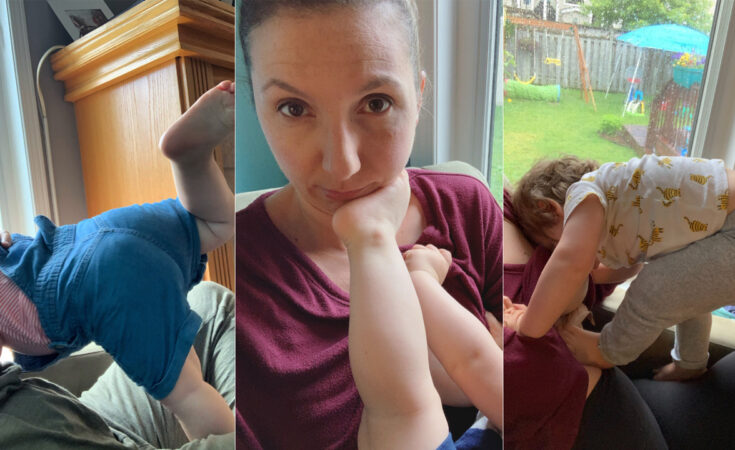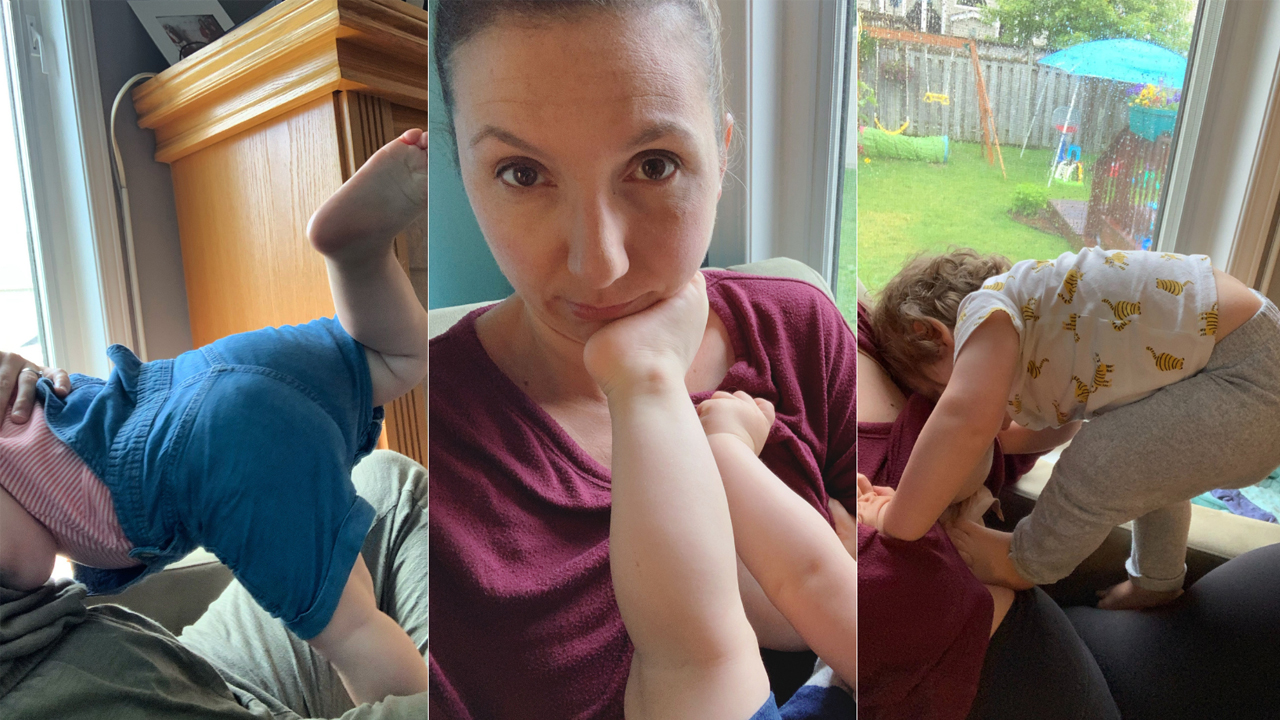Weaning my first baby was easy. I caught a stomach virus from his daycare when he was 16 months old, spent two miserable days hugging the toilet, and when I finally emerged pale, shaky, and questioning my life choices, my son had replaced me with a bottle.
I’ve had no such luck with my youngest, who is now 18 months old, can ride a balance bike and work the TV remote, and still feeds with the frequency of a newborn, but the agility of a gymnast.
“So… Do you think you’ll quit breastfeeding soon?” older family members will ask me as they watch my toddler barrel roll across my torso, taking my now four-inch-long nipple with him in his teeth.
“No. I love the tender bonding too much,” I’ll respond drily as my son round-kicks me in the face.
For parents who chestfeed their babies, deciding when and how to stop can come down to personal preference, finances, circumstance, fate, and the child’s willingness to give it up. Some babies will make the switch to bottle or sippy cups easily, as if the last several months of lactation and bonding meant nothing to them. And others will spit their cow’s milk right at you then wrestle you out of your shirt.
There’s no “right” time to wean. The World Health Organization recommends exclusive breastfeeding until six months, and continued breastfeeding until age two or beyond. But many children start attending daycare between 12 and 18 months, so your nursing sessions will be winding down (or decreasing in frequency) naturally. And sometimes, you’re just feeling done, regardless of the reason—but your kid remains stubbornly latched.
Don’t despair. Here are six tips to keep in mind as you begin to picture what weaning will look like for you and your child.
1. Communication is key
Waiting until the child is older can actually make weaning easier, thanks to the ability to communicate with them, set rules, and make it more of a mutual exchange, says Calgary lactation consultant Natalie Borden, who is also a certified birth and postpartum doula. Communication is key, whether you have the time to wean gradually or need to do make a more abrupt change.
Ottawa mom Mary Ann Lalonde took a slow, graduated approach when she felt it was time to wean her toddler, Naomi. She replaced their four feeds a day with a cup of milk instead, one at a time, starting with milk before naps when Naomi was around a year old. She spaced each swap by at least two weeks, until all that was left was the feed before bed, which she continued to offer for several months. When she was ready to cut the bedtime feed, Lalonde would offer one breast only, followed by a cup of milk.
“I would just say, ‘Would you like more milk?’ And then offer the cup,” Lalonde says. After four nights, she only offered the cup (no chestfeeding). Naomi was fully weaned by about 16 months of age.
At first, Naomi would point to the chair where they used to nurse, as if to say “No, we sit there and we do this now,” Lalonde says. So Lalonde made sure to give her lots of cuddles and stories as Naomi sipped milk from her cup.
“It’s been almost a month now, and she doesn’t point at the chair anymore,” Lalonde says.
2. If possible, go gradually
Borden, the Canadian Paediatric Society (CPS), and La Leche League International all recommend a gradual approach, like Lalonde’s, for a smoother transition for both the child and the parent. You could start with limits, such as only feeding in certain locations or at certain times of day. You could also distract your toddler with a walk or playtime during times when they used to have feedings, she added.
Start by trying to drop the feeds they have the least interest in. Usually, these are the daytime feeds (not before a sleep), Borden says.
That said, while most experts recommend a gradual approach, it’s not always possible or desirable. Some parents swear by the Bandaid trick with older children. This involves covering up your nipples with bandages and explaining to the child that you have an “ouchie” and can’t nurse. Communication with your kiddo (explaining your ouchie) is what makes this abrupt method possible, but remember to take care of your breasts, watch for signs of engorgement or blocked ducts, and express milk if you have discomfort.
Know that more abrupt approaches to weaning can lead to feelings of depression, as well as risk engorgement and even mastitis (a breast infection), says Borden, though all lactating people are different.
“Just because we’ve decided we’re not offering milk anymore doesn’t mean the body has realized that,” she explains.
Some parents may cut daytime feeds when they return to work, but plan to keep chestfeeding in the morning or evening (this is also known as partial weaning). Pumping or expressing milk during the day can alleviate breast discomfort during this period, and help maintain your milk supply for nighttime feeds.
3. Don’t offer, but don’t refuse
Often, the easiest and gentlest approach to weaning is “Don’t offer, but don’t refuse,” Borden says. For instance, if you would normally feed your toddler in a rocking chair, you might avoid that part of the house so the child isn’t as tempted, or have a non-nursing partner or caregiver rock them to sleep or put them down for their naps for about a week instead, if possible.
And if you’re in the habit of volunteering milk before naps or at certain times of the day (as in, saying “Time to nurse!” instead of waiting for them to ask), stop offering. Your child might surprise you and not even notice! If they do ask to nurse, you could try distracting them with an activity, walk, or snack.
The “don’t refuse” part gets a little trickier if your child is in the habit of nursing to sleep or always wants milk before a nap. If you decide to try giving bottles or sippy cups, the CPS recommends letting the non-nursing partner offer it, giving the baby lots of cuddles and closeness during this time, and watching for the cues you might unknowingly send your baby.
If your baby or toddler relies on nursing to fall asleep, or go back to sleep at night, you may want to consider a gentle form of sleep training as a starting point before weaning.
4. Make your body less available
Some experts advise lactating parents to stop wearing nursing bras and tops with easy access or slide slits—it’s a gradual approach that works well in combination with others. Borden agrees, adding that she would sometimes wear turtlenecks or layers when weaning her kids. “If they could see my neck or my chest area at all, it was like an open invitation.”
You may have heard other chestfeeding parents talking about going on a long-weekend trip without their baby or toddler in order to fully wean, but again, experts generally recommend a more gradual approach unless you’ve already cut most of their feeds. Plus, your baby may just want to start nursing again when you’re home, and then you’re back to square one.
5. Shorten your feeds
Another option is to shorten your feeds and cut your kid off after one or two minutes. This will also bring down a parent’s milk production, and ultimately make breastfeeding less enticing for the toddler, Borden explains.
You may even find your child start preferring a bottle or sippy cup as your supply gradually decreases.
6. You can say “No”
If chestfeeding is becoming a negative experience for you, remember that you can say “no” when your kid indicates they want to nurse. In fact, some parents find that putting boundaries and limits on the feeding relationship increases their positivity toward it, says Borden. “When they’re 18 months old, you don’t have to accept it every single time the baby wants to feed,” Borden says.
Nursing a toddler can be exhausting, physical work. They twist, they turn, they demand, they whine, and they eventually learn how to unclip your nursing bra. (Just me?) But nursing doesn’t have to be all or nothing. Establishing rules and limits can flip that power dynamic and put you back in control, if you want to keep going. (And if you don’t, that’s OK, too.)
My 18 month old will soon be starting daycare, so I’ve started saying “no” when he sprints toward our nursing chair, shouting “DIS! DIS! DIS!” at all times of the day. But at night, when he smells like baby lotion and his curls are still wet from the bath, I hold him close as he chugs away at my nipple. I remember that this precious time won’t last forever, and as he somehow contorts himself into a handstand while still latched, I thank god for that.



































